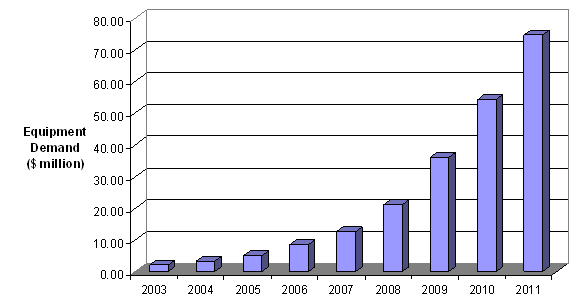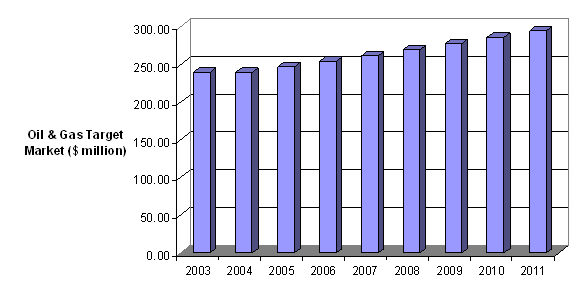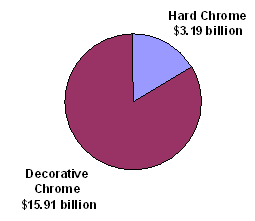Hard Chrome Plating... Its Past, Present and Future
Providers of hard chrome electroplate, a relatively small but critical component of the overall chrome plating market, have endured tremendous stress and changing market forces in the past decade...
Introduction
Providers of hard chrome electroplate, a relatively small but critical component of the overall chrome plating market, have endured tremendous stress and changing market forces in the past decade. As a result of changing health and environmental regulations, many shops that provide both decorative and hard chrome plate were forced to leave the business or move operations out of the United States. Hard chrome, used in critical applications such as aircraft landing gear and oil well equipment, is impacted by both adverse economic conditions, increased regulation and the emergence of competing coating methods.
Yet, as shown in a 2003 study by Thintri, Inc., the overall chrome plating industry is surprisingly robust. While the movement of plating operations overseas continues, for many plating shops, the difficult times appear to have passed and providers are optimistic about the future. However, for hard chrome, and to a lesser extent decorative chrome, competing technologies promise some erosion of markets late in the current decade.
Health Effects and Legislation
Chrome plating usually makes use of hexavalent chromium. Hexavalent chromium has long been known to be hazardous, but studies in the last decade have shown it to be particularly dangerous, especially for workers in chrome plating facilities.
In response to growing health concerns, the U.S. Environmental Protection Agency (EPA) began to regulate emissions into the air of chromium, citing strong evidence that hexavalent chromium causes lung cancer and other serious conditions.
The regulations focus on reducing the fine mists formed by electroplating, which is where most of the health hazards from hexavalent chromium arise. Methods recommended to reduce worker exposure to hazardous mists included use of scrubbers, mist eliminators, fume suppressants and others.
The apparently abrupt, and to some arbitrary and draconian, imposition of such stringent rules was something of a shock to the domestic chrome plating industry. A number of plating shops, many of them small, family-run businesses that had changed little for generations, could not afford to comply with the new rules and went out of business, perhaps more than half of those in the US. Many larger shops moved operations to Mexico or overseas, often to Asia, where environmental laws are less strict.
The chrome plating industry has survived by adapting to a new political environment. For many platers, cooperation with the new rules meant a complete overhaul of existing processes and facilities. Newly available technologies have allowed chrome plating facilities to function with enormously improved efficiencies and safety, and even enhanced productivity.
The trauma wrought by the regulations has faded, and the industry has reached something of a steady state. While there remains a movement of plating operations out of the country, other facilities are still shutting their doors and many in the industry complain about the difficulties of doing business, those facilities that survived the transition are, in many cases, running quite profitably. The North American chrome plating industry is, in many respects, surprisingly healthy. Chrome plating industry experts who were interviewed for the Thintri study were generally quite confident in the future of their business and did not feel threatened by alternative coating technologies.
In addition, the legislative environment has stabilized as well. While there may be new regulations to come from the Occupational Safety and Health Administration governing hexavalent chromium emissions in plating facilities and workers' exposure levels, and Japan and the Scandinavian countries are reported to have comprehensive bans on hexavalent chromium under consideration, there appear to be no near-term legislative initiatives that will significantly affect the ability of domestic chrome platers to function profitably.
Compared to its would-be replacements, chrome plating is still effective for many purposes. It is inexpensive, and can easily be performed in large batches. It is also foolproof, unlike competing plating methods that require multiple steps with complex chemistries.
Hard Chrome Market Forces
Hard or functional chrome plate comprises less than a quarter of the overall hexavalent chrome plate market (Fig. 1).
Hard chrome markets include wear resistant surfaces in aerospace, oil and gas, heavy equipment and a range of general industrial applications. Hard chrome plate is also used in restoration of dimensional tolerances, as in gas turbines where shafts require precise tolerances that may be off-target as a result of wear or manufacturing defects.
Hard chrome's desirability arises from its combination of adequate performance, with its low cost and ease of application. Chrome plating has been in use for a long time because it offers good coatings, both decorative and functional, with good properties and wide applicability, at low cost. No competing technology can really claim the same combination of performance, range of application, ease of processing and low cost.
It was precisely because of chrome's satisfactory performance that alternatives to chrome plate never received much attention until the safety and environmental push began. As legislation to control chromium pollution began to take effect, many large companies that made use of chrome plating, either out of a desire to avoid future legal problems or merely to act as good corporate citizens, made a commitment to reduce or eliminate the use of chrome plating within a period of years. In the process of investigating and developing alternative technologies, many users found good reasons to replace chrome plate in their applications beyond the simple cost and pollution issues. They gradually became aware that for specific applications, there may be substitutes that perform better than chrome plate at a comparable or even lower cost.
Chrome plate offers properties that are generally good. Still, the material offers limited hardness and corrosion resistance. If not properly applied, it can suffer from pitting, spalling, and other failures under stressful conditions.
Another problem with chrome plating is the relatively slow rate of deposition. Deposition rates in chrome plating range from four to eight microns per hour, compared with thirty microns per hour for nickel plating. Chrome processing also requires lengthy bakes following deposition. Because electroplating is a directional process, chrome coatings tend to be thicker on corners and edges, and tend to have little accumulation in recessed areas (which often can be overcome by use of conforming anodes). Lack of coating uniformity is a chief reason for follow up machining to meet dimensional tolerances.
Some parts used in demanding applications, including hydraulic rods, may have to be plated three or four times to obtain a thick, hard coating, compared with just once for an alternative technology like thermal spray.
Cost of ownership is a big complaint with hard chrome users. There is a significant need for coating processes with shorter processing time that give longer maintenance cycles.
Many experts interviewed across a range of industries in the Thintri study confirmed that their search for alternatives began out of concern for safety and the environment. However, having awakened to the superior performance of some alternatives, many users of alternatives now claim that even if all the health and environmental concerns about chromium could somehow be removed, there was no possibility of going back to their old coating processes.
While the chrome plating industry is large, stable and in no way threatened in its existence, for a number of specific applications, alternative technologies have already proven their value. In the long run, hexavalent hard chrome's dominance in many prominent applications is under threat.
Emergence of Competing Technologies
A number of coating techniques have emerged that may pose a threat to hexavalent hard chrome. While some remain in the development stage, others have already begun taking market share away from chrome plating.
Plating options include electroless nickel plating, electroless nickel composite plating, electrodeposited nanocrystalline alloys, and a few others. Trivalent chrome, which uses similar processing methods to hexavalent chrome but without most of the hazards, has already made serious inroads in decorative chrome markets. In the long run, a hard trivalent chrome coat may provide an alternative to hexavalent chrome that would allow chrome platers to maintain their client set in critical wear coating markets. To date, however, there is no satisfactory hard trivalent chrome process, but a number of companies and consortia in the U.S. and Europe have initiated development efforts.
Other methods, mostly in the development stage, include explosive bonding, laser cladding, physical vapor deposition, and electrospark deposition.
In the current decade, the greatest threat to the dominance of hard chrome is thermal spray. In each of the 14 or so forms of thermal spray, metal in powder or wire form is heated to melting and accelerated to the surface to be coated, building up to form the desired thickness. A major advantage of thermal spray is that a wide range of coating materials can be used, allowing coatings customized for individual tasks. Thermal spray coatings can be extraordinarily hard with great wear or corrosion resistance and up to a quarter inch thickness. Turnaround times with thermal spray are also low, with processing times as little as a fifth that of hard chrome.
The form of thermal spray that represents the greatest commercial threat to hard chrome is high velocity oxy-fuel (HVOF). HVOF accelerates metal particles at a relatively low temperature but high velocities onto a surface, forming coatings that are literally forge-welded to the substrate. Coating densities with HVOF can approach 100 percent, meaning there is little or no porosity. Respondents interviewed in the Thintri study indicated a solid consensus that HVOF coatings applied in wear applications provide superior performance in most situations compared with chrome.
The weakness of thermal spray is generally considered to be cost. Thermal spray is applied most often by a robot, which must be programmed for the part in question and must make frequent adjustments for parts with complex geometries. Unlike chrome plating which coats an entire surface at once, thermal spray is usually applied to an area about three quarters of an inch wide at one time. For large, simple surfaces, HVOF can often be applied more cheaply than chrome plating, but for complex geometries, HVOF processing is considerably more expensive than hard chrome. However, given the fact the HVOF coatings perform better and last longer than chrome, savings often accrue in the long term. In any case, the greater up front cost in applying HVOF has deterred many potential users.
Another important limitation of all forms of thermal spray is that it is a line-of-sight technology. For parts that lie outside the line of sight, such as inner diameters below a couple of inches, other coating methods must be used. In aircraft applications, for example, the difficulty with applying thermal spray to inner diameters will mean that the penetration of thermal spray in aircraft applications will be limited to 80 percent in the long term. The remainder may stay with hard chrome, at least for most of this decade.
Case Study: The Oil and Gas Sector
The oil and gas sector provides a harsh test for functional surfaces. Drilling and pumping equipment is routinely exposed to aggressive brines, acids and gasses. Parts requiring durable surfaces include valves, chokes, blowout preventers, mud pumps, sucker rods, heat exchangers and separators, packers, safety valves, and all types of downhole tools.
The "oil patch" was an early adopter of thermal spray as a chrome substitute, particularly HVOF, which has been in common use in that sector since 1995. For some parts, such as compressor rods, HVOF is already the dominant coating method. Other parts that are suitable for thermal spray include ball valves, hydraulic cylinder rods, mandrels and risers and tensioner rods for offshore rigs. There is also a large amount of thermal spray used in the industry that has nothing to do with chrome replacement.
Oil well equipment may be considered a less critical application area than aerospace, but it is certainly one of the most demanding. Drills must penetrate thousands of feet of earth and rock, often after going through thousands of feet of salt water. A drill ship might be 1,000 feet long, with tensioner systems that have to pull risers two miles long, each about three feet in diameter. Pinion shafts spin at high speeds, requiring high pressure lubricants, which can become a problem for coatings that aren't dense enough.
Because of the enormous size of many of the parts involved, the oil industry was sensitive early on to the high costs of thick chrome plate. With the emergence of thermal spray as an option, chrome plating often cannot compete economically.
Target hard chrome markets (i.e., those hard chrome applications that could reasonably be replaced with alternatives like thermal spray) in oil and gas applications are sizable, even though growth has stalled in the current economic climate (Fig. 2).
In the words of one industry participant, "these days chrome is a failure." The oil & gas sector is thus expected to adopt thermal spray technology, in particular HVOF, to replace hard chrome at a rate much higher than growth in the underlying target markets. The result will be greatly accelerated sales of thermal spray and equipment, even in a sluggish industry (Figs. 3 and 4).
The trend in oil and gas is typical of many other industries. Even during depressed business conditions, the switch away from chrome and toward alternatives like thermal spray will boost growth rates for those alternatives far beyond any growth in underlying target markets.
Hard Chrome Market Evolution
There remain serious concerns about the economic competitiveness of chrome alternatives like thermal spray. However, in most industries that make significant use of hard chrome, the transition away from chrome has already begun. Many businesses that use hard chrome have already set up thermal spray facilities, or have already prepared plans to do so. In several large applications, users have implemented plans that will result in replacement of 20 percent of hard chrome with thermal spray within two to three years, and up to 80 percent replacement by 2010 or shortly thereafter. While hard chrome markets are stable in the near term, by the end of the decade, serious erosion in those markets can be expected. The same pattern will be repeated in decorative chrome markets, although with somewhat less impact by alternatives.
Many providers of hard chrome plating services appear unaware, or unconcerned, about the long term threat posed by alternatives. Instead they are preoccupied by short term issues such as regulatory compliance. However, according to the Thintri study, the business landscape over the course of the present decade could change substantially in ways beyond chrome's health and safety issues.
Related Content
Products Finishing Reveals 2023 Qualifying Top Shops
Each year PF conducts its Top Shops Benchmarking Survey, offering shops a tool to better understand their overall performance in the industry. The program also recognizes shops that meet a set of criteria to qualify as Top Shops.
Read MoreLiquid Chrome Vs. Chromic Acid Flake
Contemplating how to continue offering chromic acid services in an increasingly stringent regulatory world? Liquid chrome products may be the solution you’re looking for.
Read MoreTrivalent Chrome Overview
As the finishing industry begins to move away from the use of hexavalent chromium to trivalent chromium, what factors should finishers consider as they make new investments? Mark Schario, chief technology officer for Columbia Chemical offers a helpful overview of this complicated topic.
Read MoreAdvantages to Pumped Eductor Agitation
Not all agitation methods are created equally. Pumped agitation with eductor nozzles can improve process tanks and quickly show a reduction in operating costs while keeping staff safe, following environmental legislation and preventing pollution.
Read MoreRead Next
Episode 45: An Interview with Chandler Mancuso, MacDermid Envio Solutions
Chandler Mancuso, technical director with MacDermid Envio discusses updating your wastewater treatment system and implementing materials recycling solutions to increase efficiencies, control costs and reduce environmental impact.
Read MoreA ‘Clean’ Agenda Offers Unique Presentations in Chicago
The 2024 Parts Cleaning Conference, co-located with the International Manufacturing Technology Show, includes presentations by several speakers who are new to the conference and topics that have not been covered in past editions of this event.
Read MoreDelivering Increased Benefits to Greenhouse Films
Baystar's Borstar technology is helping customers deliver better, more reliable production methods to greenhouse agriculture.
Read More

























